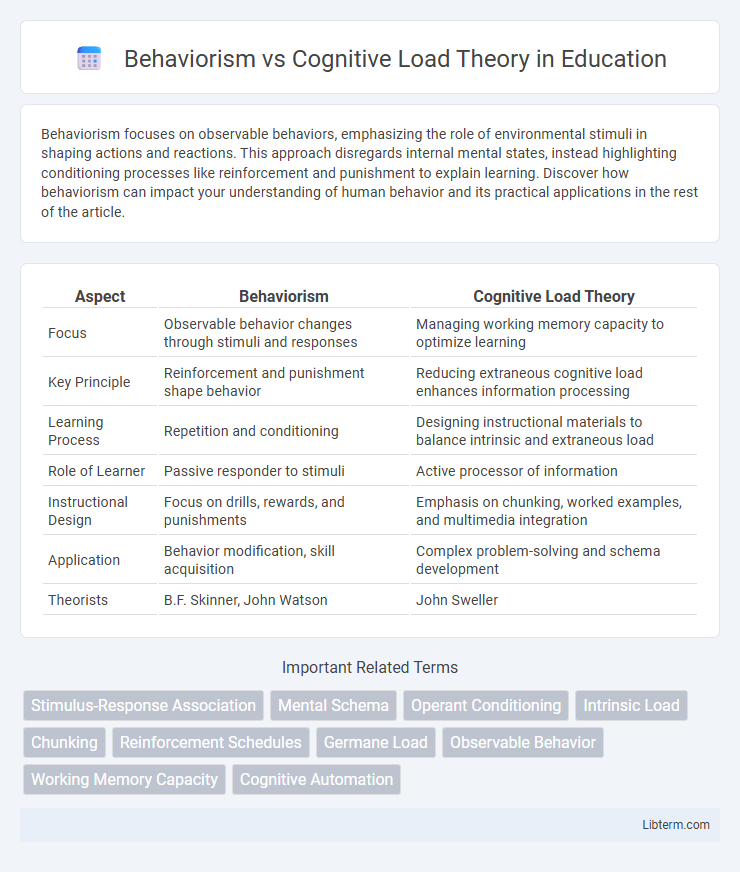Behaviorism focuses on observable behaviors, emphasizing the role of environmental stimuli in shaping actions and reactions. This approach disregards internal mental states, instead highlighting conditioning processes like reinforcement and punishment to explain learning. Discover how behaviorism can impact your understanding of human behavior and its practical applications in the rest of the article.
Table of Comparison
| Aspect | Behaviorism | Cognitive Load Theory |
|---|---|---|
| Focus | Observable behavior changes through stimuli and responses | Managing working memory capacity to optimize learning |
| Key Principle | Reinforcement and punishment shape behavior | Reducing extraneous cognitive load enhances information processing |
| Learning Process | Repetition and conditioning | Designing instructional materials to balance intrinsic and extraneous load |
| Role of Learner | Passive responder to stimuli | Active processor of information |
| Instructional Design | Focus on drills, rewards, and punishments | Emphasis on chunking, worked examples, and multimedia integration |
| Application | Behavior modification, skill acquisition | Complex problem-solving and schema development |
| Theorists | B.F. Skinner, John Watson | John Sweller |
Understanding Behaviorism: Core Concepts
Behaviorism centers on observable behaviors shaped through stimuli and responses, emphasizing reinforcement and punishment as key mechanisms for learning. Core concepts include classical conditioning, where associations between stimuli and responses are formed, and operant conditioning, which focuses on consequences shaping future behavior. This framework contrasts with cognitive theories by prioritizing external behavioral change over internal mental processes.
Key Principles of Cognitive Load Theory
Cognitive Load Theory emphasizes managing intrinsic, extraneous, and germane cognitive loads to optimize working memory capacity during learning. It prioritizes instructional design strategies such as segmenting information, using worked examples, and minimizing unnecessary cognitive burden to enhance schema acquisition. Unlike Behaviorism, which focuses on observable behaviors and reinforcement, Cognitive Load Theory centers on internal mental processes and efficient knowledge construction.
Historical Development of Both Theories
Behaviorism, emerging in the early 20th century through the work of John B. Watson and B.F. Skinner, focused on observable behavior and stimulus-response relationships, laying the foundation for experimental psychology and educational conditioning techniques. Cognitive Load Theory, developed by John Sweller in the 1980s, arose from cognitive psychology and instructional design research, emphasizing the limitations of working memory and the optimization of information processing during learning. These theories reflect distinct historical developments: behaviorism rooted in behaviorist principles of learning through reinforcement, and Cognitive Load Theory grounded in the advanced understanding of cognitive architecture and mental effort management.
Comparing Learning Approaches: Stimulus-Response vs. Mental Processing
Behaviorism centers on stimulus-response patterns, emphasizing learning through reinforcement and observable behaviors. Cognitive Load Theory focuses on optimizing mental processing capacity by managing intrinsic, extraneous, and germane cognitive loads during learning. Comparing these, behaviorism prioritizes external behavioral changes, while Cognitive Load Theory highlights internal cognitive mechanisms essential for effective knowledge acquisition.
Classroom Applications: Behaviorism in Practice
Behaviorism in classroom applications emphasizes observable behaviors through reinforcement, repetition, and structured drills to enhance learning outcomes. Techniques such as positive reinforcement, immediate feedback, and behavior shaping foster student motivation and mastery of fundamental skills. This approach is especially effective in teaching foundational knowledge and procedural tasks, where clear, measurable progress is critical.
Educational Implications of Cognitive Load Theory
Cognitive Load Theory emphasizes the design of instructional materials that reduce extraneous cognitive load to enhance learning efficiency, promoting schema acquisition and automation. Unlike Behaviorism, which focuses on stimulus-response conditioning, Cognitive Load Theory advocates for structured guidance and the use of worked examples to optimize working memory capacity. Educational practices informed by Cognitive Load Theory prioritize segmenting information, integrating modalities, and minimizing unnecessary cognitive demands to improve comprehension and retention.
Strengths and Limitations of Behaviorism
Behaviorism excels in establishing clear, measurable learning outcomes through repetitive practice and reinforcement, making it effective for skill acquisition and behavior modification. Its limitations include neglecting internal cognitive processes, which reduces its ability to address complex problem-solving or creative thinking tasks. Behaviorism's focus on external stimuli and responses often overlooks individual differences in learning styles and the importance of mental effort described in Cognitive Load Theory.
Strengths and Limitations of Cognitive Load Theory
Cognitive Load Theory excels in optimizing instructional design by managing working memory limitations, enhancing learning efficiency especially for complex tasks. Its strengths lie in reducing extraneous cognitive load and promoting schema automation, which improves knowledge retention and transfer. Limitations include challenges in accurately measuring cognitive load and the theory's less applicability to highly creative or non-linear problem-solving scenarios.
Integrating Behaviorism and Cognitive Load Strategies
Integrating behaviorism and cognitive load theory enhances learning efficiency by combining reinforcement-based practice with cognitive processing management. Behaviorist strategies, such as immediate feedback and repetitive drills, establish strong stimulus-response associations, while cognitive load techniques optimize working memory by segmenting tasks and reducing extraneous information. This blend supports durable skill acquisition and deeper understanding by aligning behavior modification with effective cognitive resource allocation.
Choosing the Right Approach for Effective Learning
Behaviorism emphasizes repetitive practice and reinforcement to shape observable behaviors, making it effective for skill acquisition and habit formation. Cognitive Load Theory prioritizes managing working memory by designing instructional materials that minimize unnecessary cognitive demands, enhancing comprehension and problem-solving abilities. Selecting the right approach depends on learning objectives: behaviorism suits tasks requiring automatic responses, while cognitive load theory excels in fostering deep understanding of complex information.
Behaviorism Infographic

 libterm.com
libterm.com